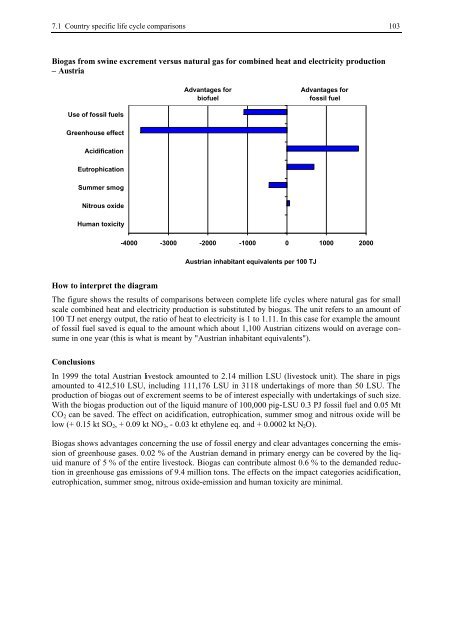BIOENERGY FOR EUROPE: WHICH ONES FIT BEST?
BIOENERGY FOR EUROPE: WHICH ONES FIT BEST?
BIOENERGY FOR EUROPE: WHICH ONES FIT BEST?
You also want an ePaper? Increase the reach of your titles
YUMPU automatically turns print PDFs into web optimized ePapers that Google loves.
7.1 Country specific life cycle comparisons 103<br />
Biogas from swine excrement versus natural gas for combined heat and electricity production<br />
– Austria<br />
Use of fossil fuels<br />
Greenhouse effect<br />
Acidification<br />
Eutrophication<br />
Summer smog<br />
Nitrous oxide<br />
Human toxicity<br />
How to interpret the diagram<br />
Advantages for<br />
biofuel<br />
-4000 -3000 -2000 -1000 0 1000 2000<br />
Austrian inhabitant equivalents per 100 TJ<br />
Advantages for<br />
fossil fuel<br />
The figure shows the results of comparisons between complete life cycles where natural gas for small<br />
scale combined heat and electricity production is substituted by biogas. The unit refers to an amount of<br />
100 TJ net energy output, the ratio of heat to electricity is 1 to 1.11. In this case for example the amount<br />
of fossil fuel saved is equal to the amount which about 1,100 Austrian citizens would on average consume<br />
in one year (this is what is meant by "Austrian inhabitant equivalents").<br />
Conclusions<br />
In 1999 the total Austrian livestock amounted to 2.14 million LSU (livestock unit). The share in pigs<br />
amounted to 412,510 LSU, including 111,176 LSU in 3118 undertakings of more than 50 LSU. The<br />
production of biogas out of excrement seems to be of interest especially with undertakings of such size.<br />
With the biogas production out of the liquid manure of 100,000 pig-LSU 0.3 PJ fossil fuel and 0.05 Mt<br />
CO2 can be saved. The effect on acidification, eutrophication, summer smog and nitrous oxide will be<br />
low (+ 0.15 kt SO2, + 0.09 kt NO3, - 0.03 kt ethylene eq. and + 0.0002 kt N2O).<br />
Biogas shows advantages concerning the use of fossil energy and clear advantages concerning the emission<br />
of greenhouse gases. 0.02 % of the Austrian demand in primary energy can be covered by the liquid<br />
manure of 5 % of the entire livestock. Biogas can contribute almost 0.6 % to the demanded reduction<br />
in greenhouse gas emissions of 9.4 million tons. The effects on the impact categories acidification,<br />
eutrophication, summer smog, nitrous oxide-emission and human toxicity are minimal.

















